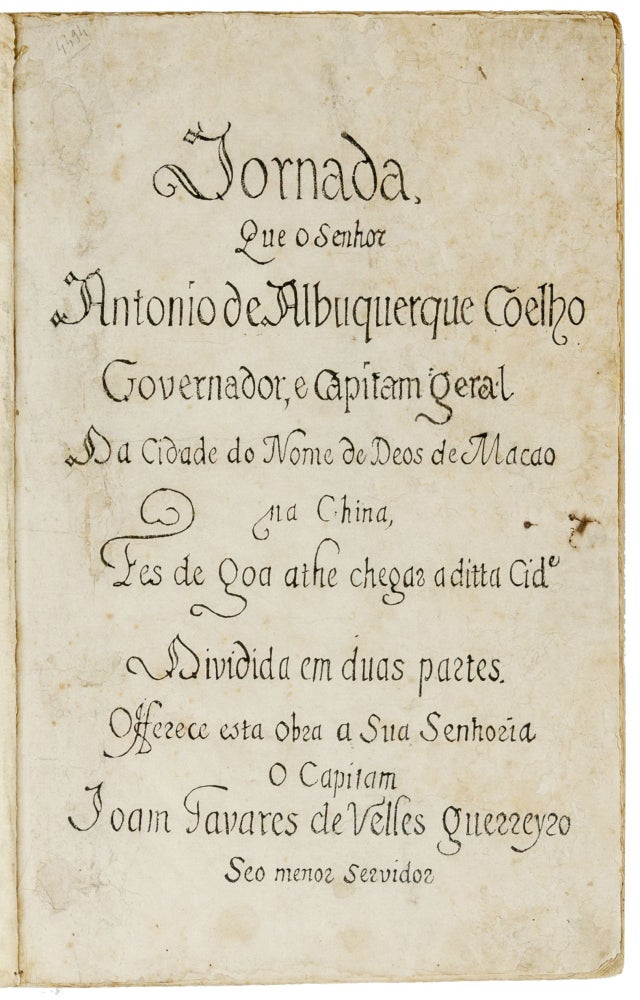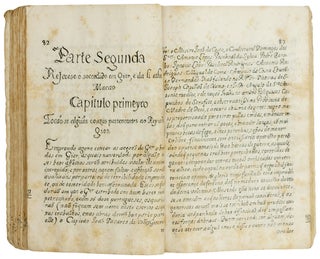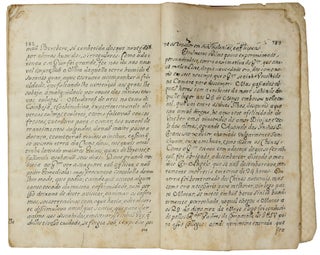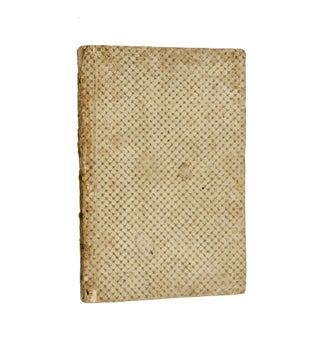Jornada, Que O Senhor Antonio de Albuquerque Coelho, Governador, e Capitan Geral Da Cidade do Nome de Deos de Macao na China, Fes de Goa athe chegas a ditta Cide Divida em duas partes.
Large 8vo. [25 x 16.5 cm], 187 ff. including title-page and one blank. Xylographic (woodblock) printing on conjugate leaves (subsequently cut open), contemporary European binding in green morocco slipcase. Two early inscriptions on fly leaf: “partido... 2 de Junho de 1717 e... e 29 de maio 1718” and “l’histoire de ce voyage nous fait voir l’ascendant que conservait encore le nom portugais dans l’Orient malgré l’extrême décadence qu'avait entraîné le passage de ces états sous la Couronne d'Espagne. A d’Albuquerque était manchot, ayant perdu le bras droit dans une bataille”. Very slightly shaved in its outer margin but a tall copy, some foxing throughout, very slight worming in the upper outer corner on last leaves only. Title page skillfully restored. Very rare first edition of this account of Antonio de Albuquerque Coelho’s 1717-1718 journey from Goa to Macao. Part I describes his circuitous route to Johore (in modern-day Malaysia); Part II, his six-month stay in the province—and unforeseen involvement in the coup that allowed the Sumatran adventurer Raja Kechil to overthrow Sultan Muda Mahmud. Written by Albuquerque’s trusty aide-de-camp shortly after their arrival in Macao, the Jornada is the last of the 11 books printed on Macao between 1662 and 1718, and the only one whose contents are secular. Albuquerque’s journey between the two Portuguese colonies was exceptionally eventful. Appointed to the governorship of Macao, Albuquerque was due to set sail from Goa on May 22, 1717. The ship’s commander was, however, a personal enemy, and used the pretext of an imminent storm to leave a few hours before Albuquerque’s embarkation. Since there wasn’t time to prepare another vessel before the onset of the monsoons, this would normally have deprived Albuquerque of the governorship. But he was not so easily daunted and resolved to cross India by land to Madras—a journey never before attempted by a European of his rank and standing—and sail from there. The party reached Madras after 50 arduous days, spent two weeks fitting out a ship, and set sail in early August. The difficulties of adverse winds and lack of water were compounded when Alburquerque lost his pilot and was forced to navigate the vessel himself. After two perilous months, the ship put into Johore where it was obliged to winter. Despite having only a handful of Europeans with him, Albuquerque took a prominent part in the revolution that saw the overthrow of the Sultan and victory of the adventurer Raja Kechil. By an adroit combination of force and diplomacy, Albuquerque contrived not only to back both of the contestants in turn (and in the right order), but so impressed the Malay rulers that he concluded a formal treaty with them that gave the Portuguese a plot of land at Johore Lama on which to build a church, and the permission to send missionaries. Resuming his voyage in mid-April—and still acting as a pilot and navigator for want of a real one—Albuquerque eventually reached the island of Saint John in the South China Sea, where, since his crew were all too sick with scurvy to work, Albuquerque transferred into a Chinese junk. He reached Macao on the 30th of May 1718, a year to the day after leaving Goa. Boxer records only six copies, two of which are incomplete. To these should be added a copy sold at Sotheby’s in 1987 at the Robinson sale and the present copy. *Braga, The Beginning of printing in Macao, 12-13; C. R. Boxer, “Some Sino-European Xylographic books 1662-1718”, JRAS (1947) n° 11, 209-211; Boxer, “A Fidalgo in the Far East, 1708-1726, Antonio de Albuquerque Coelho in Macao,” The Far Eastern Quaterly (1946) I:4, 386-410.




